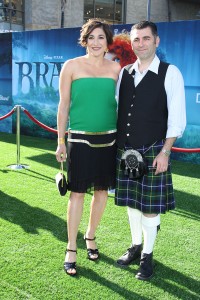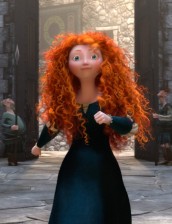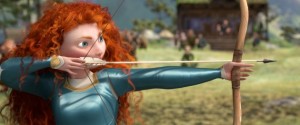In Walt Disney Pictures/Pixar’s new animated feature film BRAVE, we are the misty and magical realm of ancient Scotland, where young Princess Merida (voiced by Scottish actress Kelly Macdonald) finds that she must fight to save her family and the kingdom when a magical spell goes awry.
BRAVE producer Katherine Sarafian has been working with Pixar since the days when first TOY STORY film was in production during the 1990s. She served in a number of capacities on TOY STORY 2, A BUG’S LIFE, MONSTERS INC. and THE INCREDIBLES and produced the short film LIFTED. BRAVE is Sarafian’s first gig as producer on a full-length feature film; She talks here about the process of shepherding BRAVE from storyboard to final cut.
ASSIGNMENT X: When you were a child, did you want to have storybook adventures, or did you know even then that you wanted to be a storyteller?
KATHERINE SARAFIAN: I knew that I wanted to work in show business and that I wanted to be a storyteller, yes. I didn’t know what kind – I thought I might be a writer, I thought I might be an actor, I thought I might be a singer, but yes. I never thought that I’d be a producer, but I didn’t know that existed [laughs]. But I definitely knew I wanted to be in show business, entertainment.
AX: How did you wind up at Pixar?
SARAFIAN: I was at UCLA Film School in the Master’s program. In my last year of the Master’s program, there were various different guest speakers coming in for lectures. I was already taking a lot of classes that were more technology-focused, new applications for film, all of these things that, in the early Nineties, were burgeoning fields, with JURASSIC PARK and TERMINATOR 2 and TOTAL RECALL and these movies that had a lot of effects in them. So one of the guest speakers was from Pixar and showed a couple of short films and it was like, “Wow, you make stories out of this stuff?” [The films had] lots of special effects. I was very interested. I heard they were in Richmond, California and I was very interested in moving to the Bay Area, so I sent resumes right then and there. I sent two resumes, one to the Shorts Division and one to the Features Division, not knowing that what “features” meant was that they were making TOY STORY. I came in and I worked for TOY STORY [as production schedule coordinator].
AX: BRAVE feels like it is based on traditional Gaelic folklore. Is there any specific story that inspired it?
SARAFIAN: No, there’s not. [BRAVE] was influenced by that kind of folklore, we wanted it to have that feel. We learned there was so much mythology and legend and folklore in the region, but we didn’t want to lift one specific tale, because we were very much excited about making our own story. Although I think we like the idea that people ask, “Is this one of the real legends?” We like that, because that means we got the spirit of it and the tone of it right, but no, it’s completely original.
It is a little bit more dark and intense, and it has these moments [of intensity], and we definitely believe that telling them that way, with heart and humor, was the way to go. We wanted to show real consequences to Merida’s actions. We were definitely inspired by the old Grimm tales and the dark tales where life’s not easy and it’s not all great and touchy-feely. There are [bad things] that can happen. She needs to make a choice that will have real impact, and you need to have that intensity to it. It’s a PG movie, and every parent is going to know what the sensitivity of his or her child is, but it’s a PG movie, for sure. And we wanted it to be. We didn’t want to shy away from that.

Katherine Sarafian and husband Meher Gourjian at the World Premiere of BRAVE and the Grand Opening of the Dolby Theatre, part of the 2012 Los Angeles Film Festival | ©2012 Sue Schneider
AX: BRAVE is set in Scotland, and your voice cast is mostly Scottish actors – Kelly Macdonald, Billy Connolly, Robbie Coltrane, Craig Ferguson and Kevin McKidd, with two English actresses, Emma Thompson and Julie Walters, doing Scots accents, as opposed to having Americans doing Scots accents. Was there a decision at the outset to use actual Scottish actors?
SARAFIAN: No and yes. The truth is that we always want the best performances and we actually didn’t get all Scots, but we were going for, first, “Who embodies that big warrior and has the presence of a king, but the comedy chops of this kind of gregarious fellow and then the warmth of a father?” And really, the one name that came to mind was Billy Connolly. And he happened to be Scottish. There were others on the list, but they were far below, and we wanted Billy. And that’s kind of the way the casting process went, [casting] first for that presence and performance, and with Emma Thompson, [she had] the bawdiness and yet the warmth of a mother and yet the stature of queen. There is a short list of names that come up with those kinds of roles. The Scottishness was great. We were willing to teach people an accent, if they needed to learn the accent. We wanted the performance first. It was great that the accent came for free on most of them.
AX: You also have Pixar regular voice actor John Ratzenberger in there. Is there a Pixar law that he will be in all Pixar films?
SARAFIAN: We weren’t told, “You have to use him.” We were asked, “Do you want to use him, because he’s been in all of our films?” I think if they said, “You have to use him,” we [wouldn’t], because he’s not right for it, but we thought it would be fun to use him as a guard and keep up the tradition. So he doesn’t have a lot of lines, but he’s in there.
AX: What was your biggest challenge in making BRAVE – animating Merida’s hair?
SARAFIAN: It’s hard to choose our biggest challenge, because there were many [laughs], but really, story was the biggest challenge, trying to get that story right and continuing to hone it. Working on that mother/daughter relationship was very, very challenging, to try to make them both appealing and have them grow over the course of it. Technology-wise, we had to create some version of hair, garments and a tactile Scottish forest throughout the process, where you could feel like you were really in Scotland, and that this character [Merida], who had this untamed wild spirit would have untamed wild hair. That was a huge technological undertaking, and we created the software to make it. We were going into an ancient time period. Pixar had never done that before. Stuff looked different then – teeth were crooked, there’s something growing on everything. There are no clean, sharp surfaces. The computer likes clean, sharp surfaces, so this was as difficult as you can make things for our technology and our artists.
AX: How did you and the animation team achieve the look of BRAVE?
SARAFIAN: Research, research, research. In our case, we went to Scotland twice. We went way, way deep in. We touched everything, we stole heather and brought it back with us. We [looked at] the skies and talked to people to hear the rhythm of the language. All of that was really important. Sketches, drawings, photographs, video. We brought it all back and looked at it in California and tried to create this world that was very much hand in hand, as Merida says, “The land is as much a part of us as we are of it.” We really wanted Scotland as this character in the movie. This movie wouldn’t work in a neighborhood off Hollywood Boulevard. You’ve got [to feel] tied to the land and the ruggedness of it and the change of it. You’ve got a diverse landscape. It’s a place where change happens.
AX: What were the production research trips to Scotland like?
SARAFIAN: I would say that first time we went to Scotland in 2006 was very special, because it was the first time we really connected story and place in a real way. It had to make sense back in California, but it was a Scottish-set adventure. Well, not until we got there, saw it, smelled it, saw the skies changing, touched it and listened to the rhythms of the accents and the people and the storytellers, that we really got it, why there is such folklore and legend and the magic of tales from that region. It’s a real thing, and you feel it. And also there was a lot of bonding that happened on that trip, when twelve gentlemen are sharing a dorm room together or whatever, that makes you go into battle together for a long haul, and you stick together because you’re family by then. And you need to be. These movies are a marathon, not a sprint, and you’re in it and you want to [work with] this community of people. So there’s a closeness formed there.
AX: You have a main character who becomes a bear, but retains human characteristics. How was that accomplished?
SARAFIAN: We had a lot of video footage of bears, but we don’t have bears acting like people [laughs], so Mark Andrews’ direction on that was, “Animate her as a human in a bear suit.” So we tried to animate her as a human who just happened to be in a bear suit. And that was the goal for the animators to work with. Because if we said, “Make her a human,” or “Make her a bear,” that would have been too [extreme in either direction]. But a human in a bear suit, that’s something they could get in their heads and try. We do have a mirror room, where they’d stand in front of a mirror and act it out themselves of what they think it would be, but there’s no way you could really actually put on a bear suit and do that.
AX: Is there any motion-capture with the human characters or horses?
SARAFIAN: We do all original animation. When Emma Thompson was recording, we put a little camera in just to show her movement. She gets great expressions, particularly part of her face – she does amazing forehead work. So we’ll look at that and get ideas from it, but we don’t actually capture it.
AX: BRAVE was originally being directed by Brenda Chapman, who is credited with the original story for the film and co-wrote the screenplay, which is also credited to Steve Purcell, Irene Mecchi and Mark Andrews. Mark Andrews came in as the director on BRAVE. What happened?
SARAFIAN: [Chapman] remains a credited director on the film and has stayed with the project, but not in the day-to-day directing duties. Eighteen months ago, Mark Andrews came and took over. And what happened is what happens on many of these films, in fact, almost half of them. It’s common in the industry and at Pixar – we change directors partway through a show when things aren’t advancing the way we need them to, sometimes it’s about changing energy, sometimes it’s about changing the story. In our case, it was creative differences and Mark took over and he didn’t re-conceive things, but he really built on what Brenda had done. Mark had been involved in the earliest stages, and definitely he was a consultant on our first Scottish research trips, so he knew the material already.
AX: Some filmmakers have said that when making an animated film, pre-production, production and post-production are all sort of happening at the same time, rather than the linear way live-action films are made. Would you agree with that?
SARAFIAN: Pre-production and production do sort of blend together. There’s not this clean line, because we’re going a sequence at a time. As the movie starts jelling, it never jells as a whole, like, “Hey, there’s a whole movie, wow.” It’s always like, “Hey, the beginning’s kind of working, let’s start working on that. And this middle part’s kind of working, let’s start animating that.” And then all the parts around it, we’re constantly changing. So that is very nonlinear. Post-production, we send it to post in batches as well. So yeah, there’s quite a bit of overlap.
AX: Does Pixar still make films the same way as when you got there?
SARAFIAN: You know, they really do. It’s shocking. The things that have changed through the years – like the studio has grown and moved to a new space in Emeryville, there are more films being made, [Pixar chief] John Lasseter has mentored other directors, so there are more people directing movies – all these other directors have joined our ranks, they’re not all directed by John Lasseter any more. But the thing that’s stayed the same, I think, is more interesting. We [see] movies the same way. Technology will increase in speed and you have more [varied] means of making films, but the story process is still this churn of storyboard, redo it, redo it, redo it, look at it, tear it apart, redo it – that’s really been the same the whole time. We’re always self-critical, still.
AX: Is there anything else you’d like to say about BRAVE?
SARAFIAN: I hope that people can find the bravery in themselves and look at this and have some sort of personal experience when enjoying the movie or watching the movie, because I personally find it relatable on a lot of levels, and we hope other families do, too.
LET YOUR VOICE BE HEARD – COMMENT BELOW
Related: Interview with BRAVE composer Patrick Doyle
Related: Movie Review – BRAVE
Related: Interview with BRAVE co-director and writer Mark Andrews
Related: Exclusive Photos from the BRAVE world premiere and grand opening of the Dolby Theatre
Follow us on Twitter at ASSIGNMENT X
Fan us on Facebook at ASSIGNMENTX
Article Source: Assignment X
Article: Exclusive Interview with BRAVE producer Katherine Sarafian
Related Posts:













